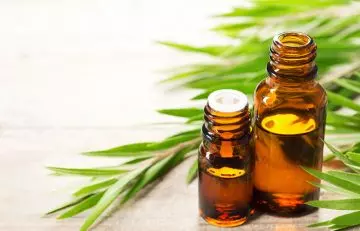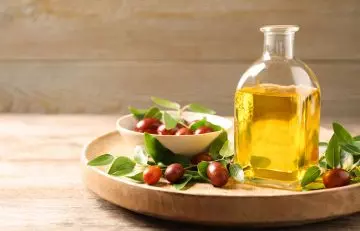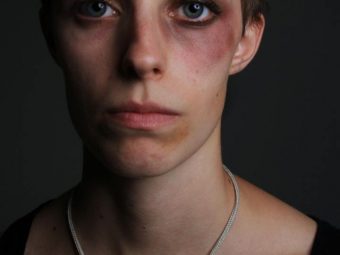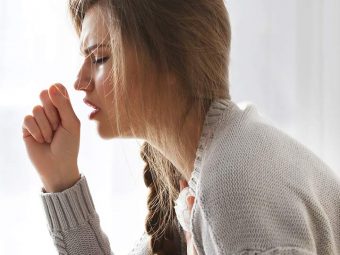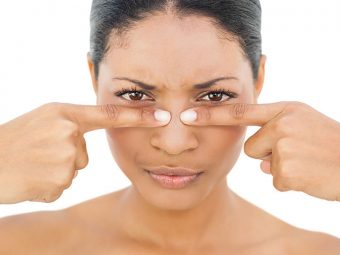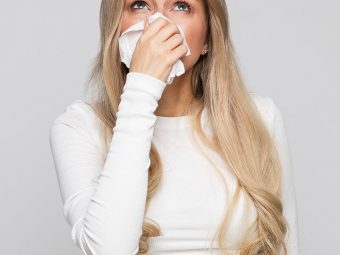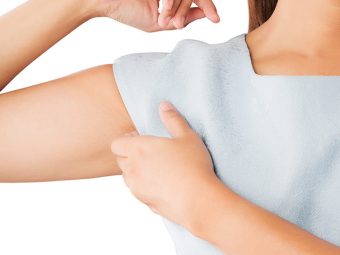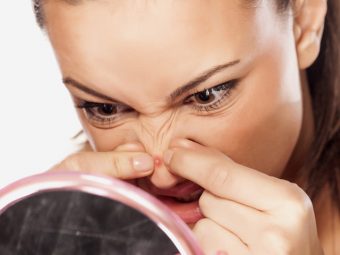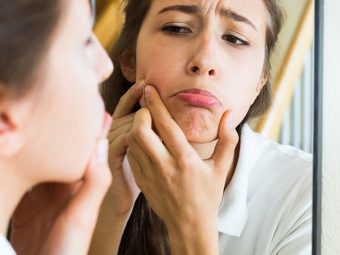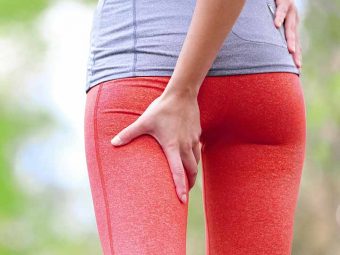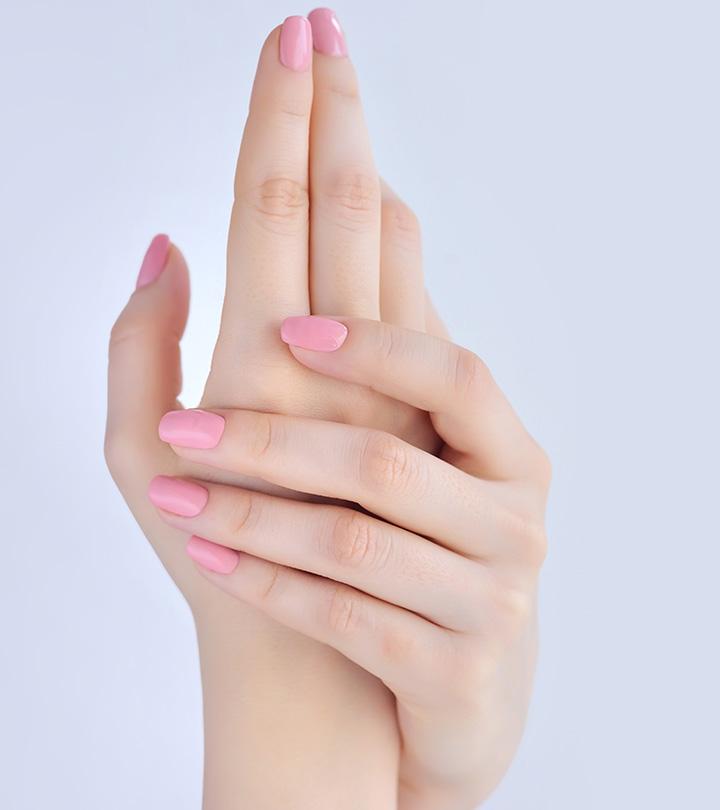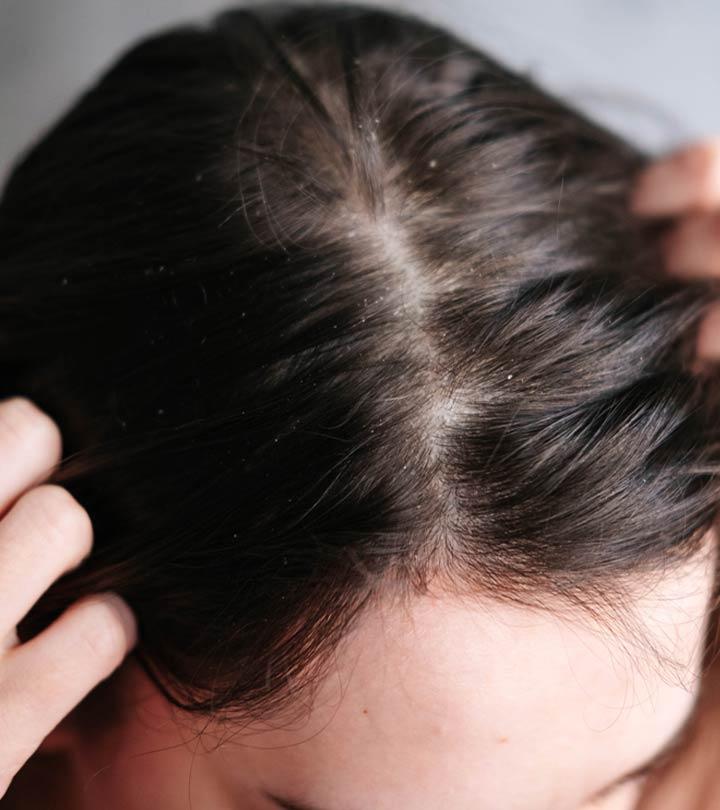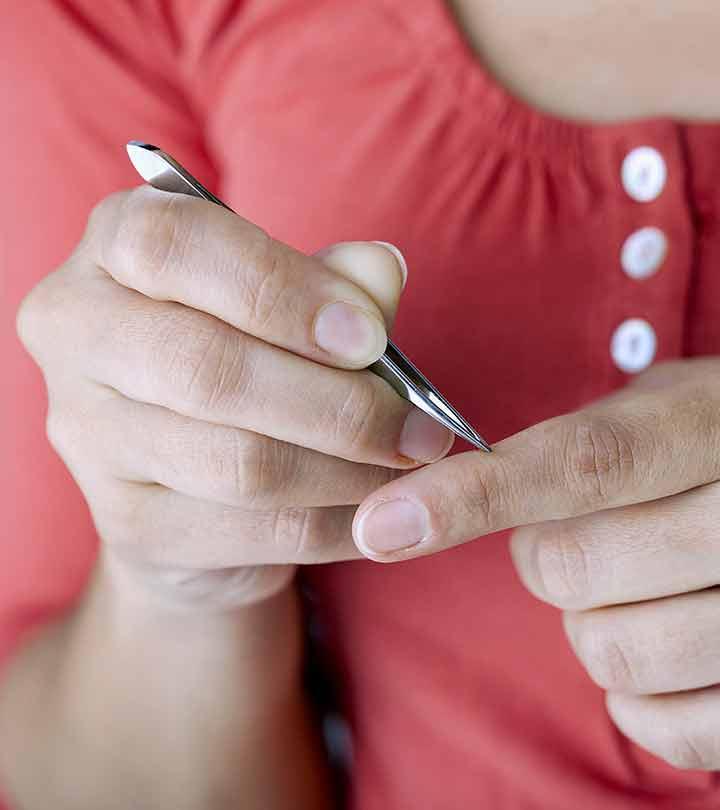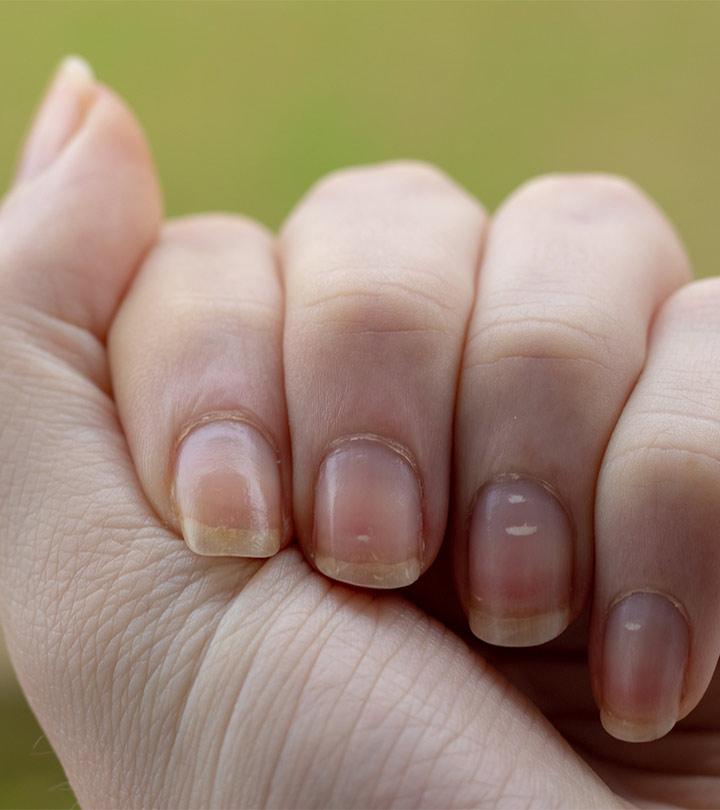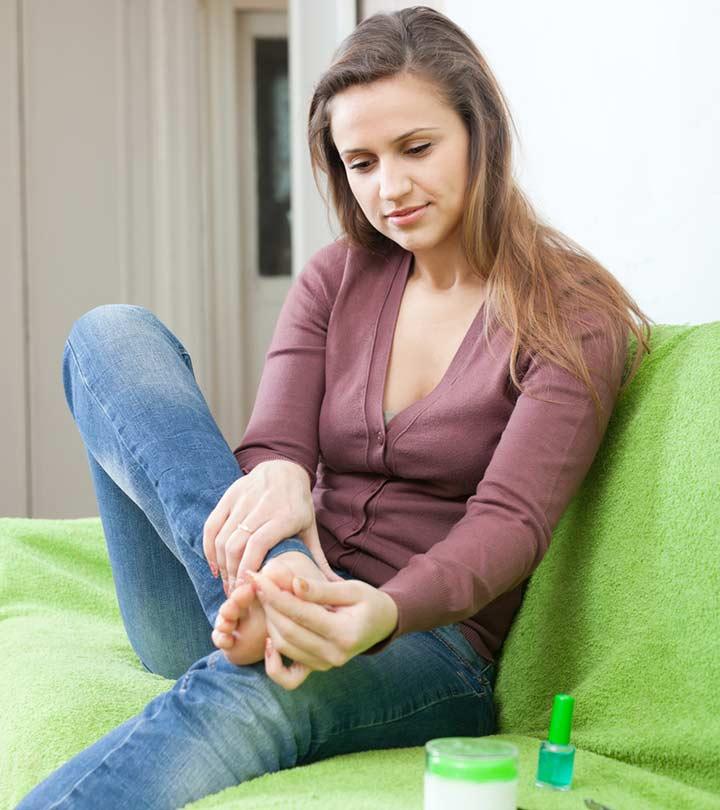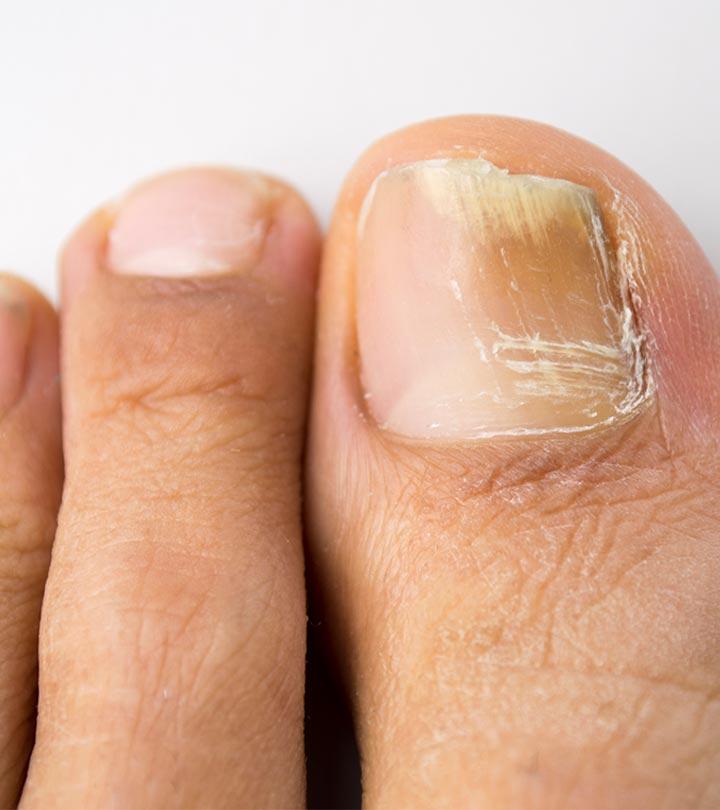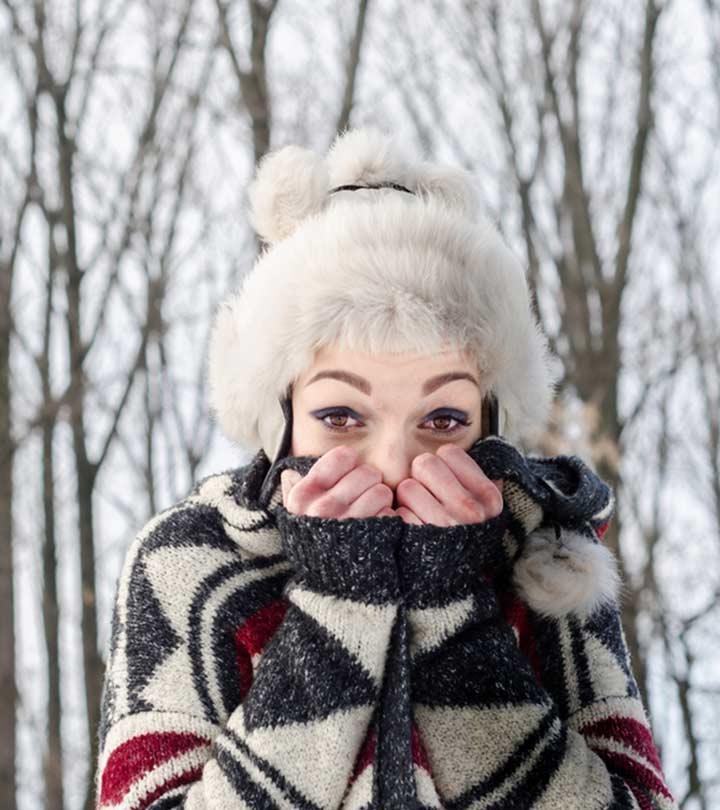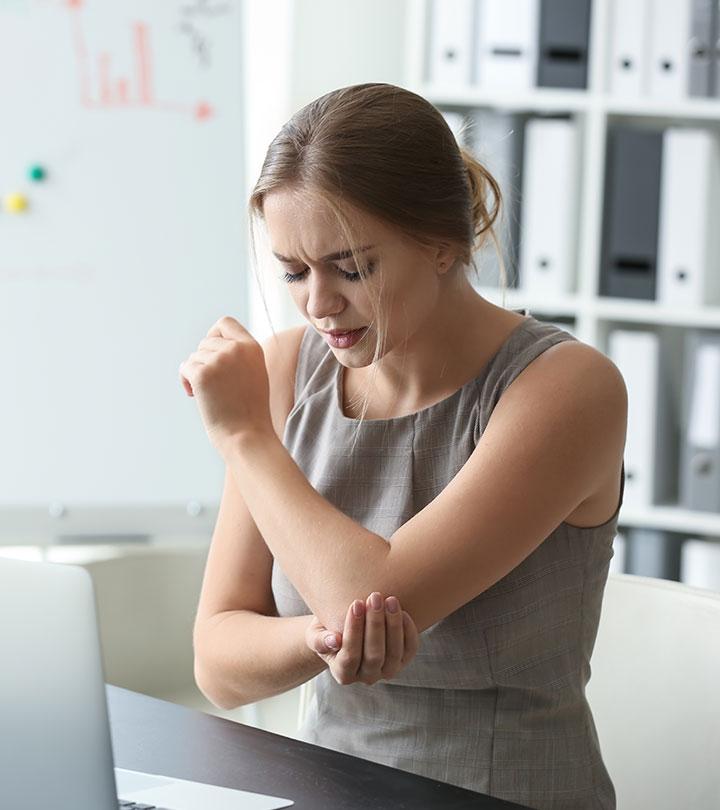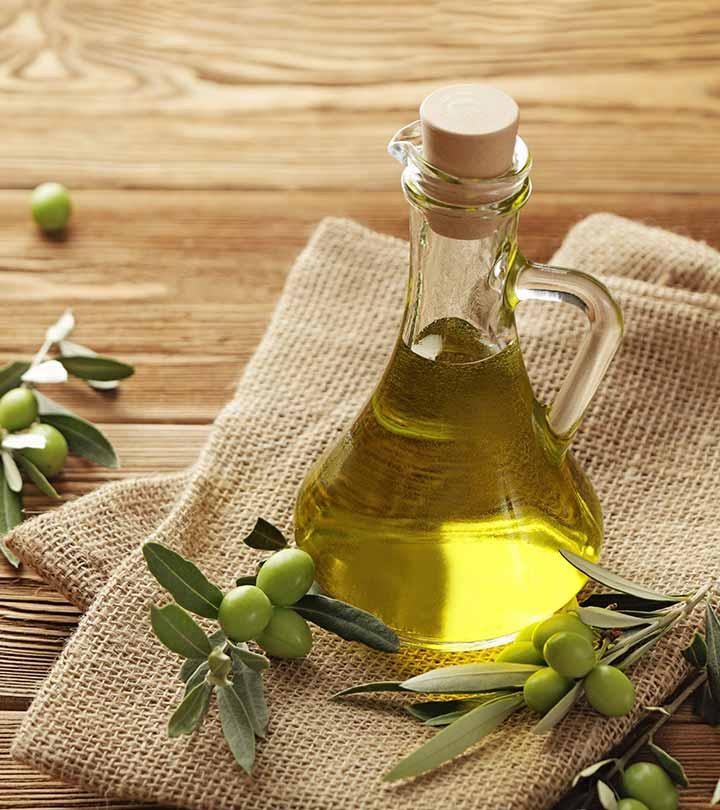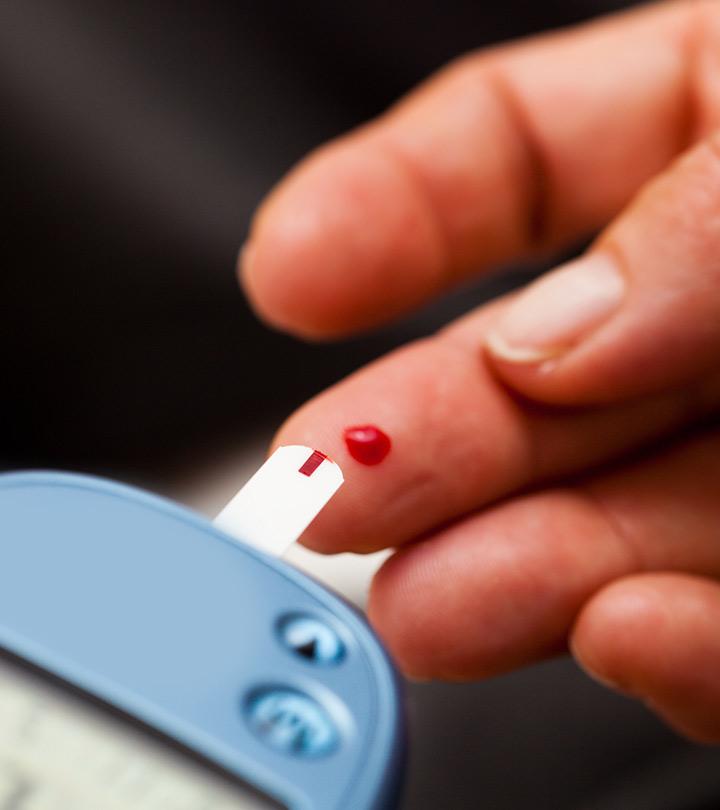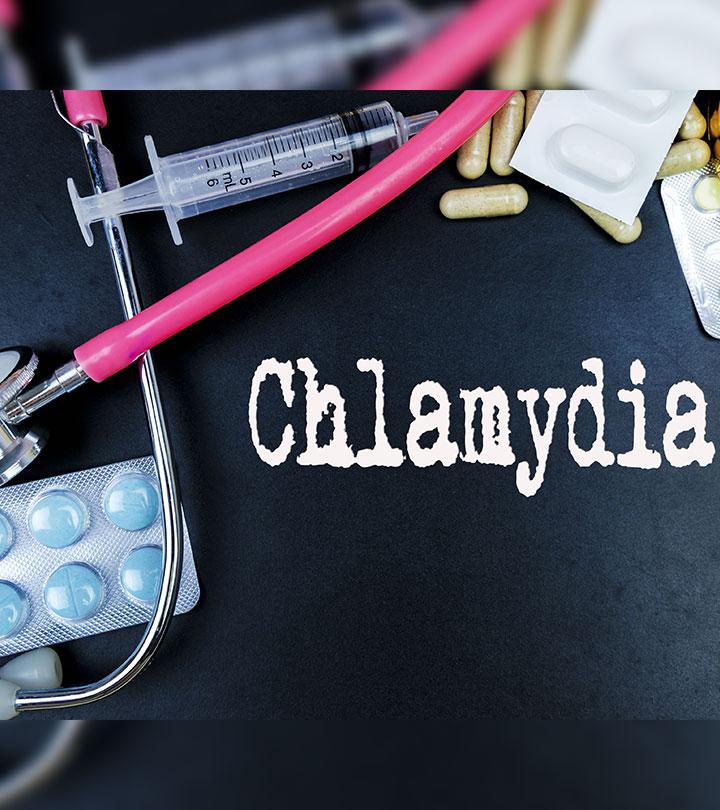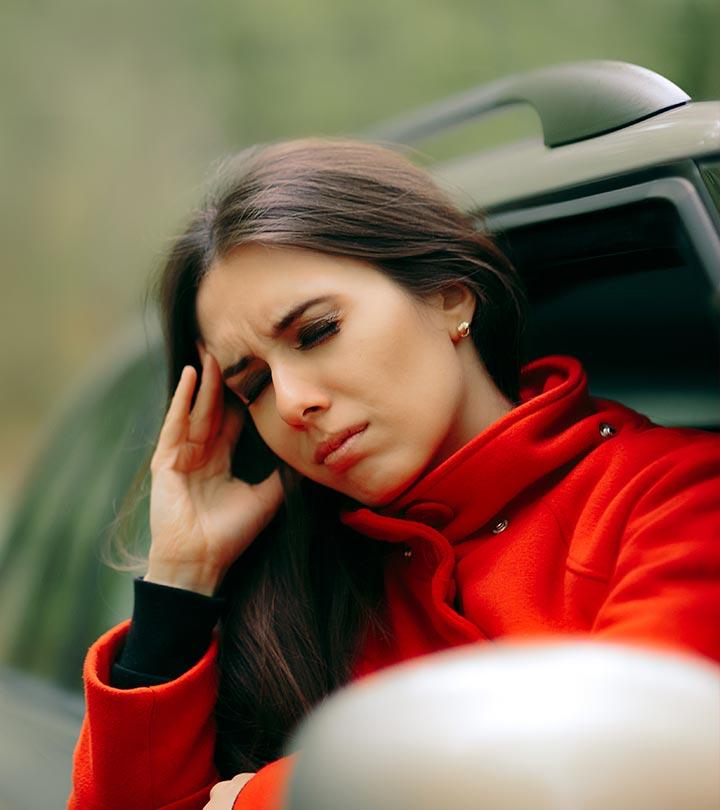How To Get Rid Of Pimples Fast: 13 Home Remedies & Diet Tips
Skin breakouts are more common than anyone would like; luckily it's mostly easy to make them go away.
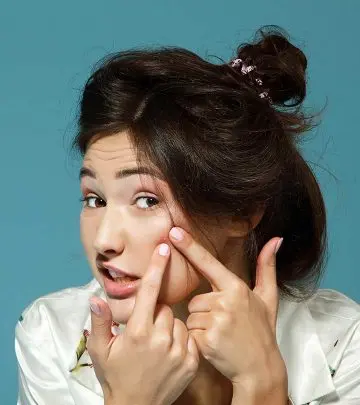
Image: ShutterStock
Most of us experience pimples and zits from stress, hormonal changes, or exposure to pollution. All these factors block your pores with grime and dead skin, which results in zits and pimples popping up all over your skin. But do you know how to get rid of pimples quickly and effectively? While medical creams and ointments work effectively, they don’t get rid of pimples overnight. They can also lead to irritation and dryness.
This article looks at a few home remedies that can help you get rid of pimples overnight. Check them out!
In This Article
What Are Pimples?
Our skin has oil-producing glands called sebaceous glands. Sometimes, when these glands get clogged, they can cause lesions filled with pus to develop. These lesions can be inflamed and appear like red boils and are called pimples. Pimples (also known as zits) are a symptom of acne. They can occur at any age but are commonly seen during puberty (1).
According to the American Academy of Dermatology (AAD), acne affects nearly 50 million Americans each year. It was further reported that 85% of people aged 12-24 may experience minor acne at least once in their lifetime. Additionally, 15% of adult women experience acne every year.
There are many factors that can make you susceptible to acne and leave you with pimples on your face. Learn more about the causes of acne in the next section.
What Causes Pimples?
- Pimples are observed to occur on the face, back, shoulders, and chest due to the presence of sebaceous glands in these areas. These glands can get clogged due to dirt or excess oil buildup, leading to pimples (1).
- Bacteria live on your skin. One of them is Propionibacterium acnes. When the sebaceous glands are clogged, it increases the amount of P. acnes, leading to inflammatory acne symptoms (1).
- Zits are most likely to show up during puberty due to hormonal changes. This is because, all through puberty, there is a change in hormone production. This causes the sebaceous glands to work overtime and produce sebum in excess (1).
- Inflammatory dietary habits can cause acne too. Eating a high glycemic diet may leave you more prone to acne breakouts (1).
- Other causes include bad environmental conditions, like pollution and a sedentary lifestyle (1).
There are a few signs and symptoms you can look out for if you suspect that you have acne. Find out more about them in the next section.
Signs And Symptoms
Pimples themselves are a symptom of acne. However, you may mistake rashes or allergic boils for pimples. Here are some signs that indicate the breakout on your face is a pimple (1):
- Skin bumps (especially after you eat fatty food or leave your face unwashed for too long)
- Redness
- Swelling
- Bumps with yellow pus at the tips (known as pustules)
- Tenderness and pain
Alex Hernandez, a licensed esthetician, says, “Some forms of acne can cause mild to severe discomfort for the people experiencing them. This is typically controlled by a few factors like the amount of inflammation present and the area where the pimple is located. Usually, the more inflamed a pimple is, the more painful it can be.”
Pimples can be painful to deal with, which is why many people want to know how to remove pimples overnight at home. Find out if this is possible in the next section.
Is It Possible To Get Rid Of Pimples Overnight?
Pimples are formed as a result of clogged pores. The pores in your skin get clogged with sebum or impurities that give rise to pimples. So, if you want to find out how to get rid of acne overnight, it is fair to tell you that getting rid of the red, inflamed lesion can be a little time-consuming and cannot be treated overnight.
It takes about 2-3 days to see the effect of a treatment procedure on your pimples. If you resort to natural remedies, it could take slightly longer. All these methods aid in fading away the pimples and acne over time, but they cannot be treated overnight.
However, if you are looking to know how to get rid of a pimple overnight, you could try the following methods that will help dry out and reduce the size of the pimple:
- You could try using a pimple patch or an acne patch. A pimple patch is essentially a hydrocolloidi XThick, waterproof, moisture-retentive dressings for open wounds. They create a moist and clean environment for wound healing. bandage that may or may not be enhanced with active ingredients. Stick it on the pimple to enable healing and aid the removal of superficial impurities from the site. This could be useful in treating smaller breakouts on your skin.
- Another quick fix is using concealer on the site of the breakout to hide the pimple temporarily.
Here are some natural ways to reduce the occurrence of pimples.
How To Get Rid Of Pimples Naturally
Pimple breakouts can be frustrating, especially when you have somewhere to go. But, thankfully, there are some home remedies for pimples that may help you to reduce them and you can easily include them in your skincare routine.
Note: Perform a patch test before using any natural remedies to check for allergies or adverse reactions. If you notice any swelling, redness, or irritation, stop using the ingredient immediately.
1. Tea Tree Oil
Tea tree oil is considered one of the best overnight home remedies for acne. It is known to possess antimicrobial properties (2). This may help in reducing the occurrence of pimples, inflamed lesions, and zits on your skin. Do not apply tea tree oil topically if you are allergic to it as it may cause a burning sensation on your skin.
What You Can Do: Mix 2-3 drops of tea tree oil with a carrier oil (sweet almond oil or jojoba oil). Apply this mixture on the pimples. Leave it on for an hour before washing it off. Repeat once daily until the redness and inflammation reduction.
2. Argan Oil
Argan oil contains bioactive groups of compounds like carotenes, xanthophylls, and tocopherols that possess antimicrobial properties (3). A cream containing argan oil was found to reduce sebum production (4). These properties may help in reducing the infection around the pimple and preventing the clogging of pores with sebum.
What You Can Do: You will need a few drops of argan oil and carrier oil. Mix them and apply it on the pimple using a sterile cotton ball. You can do this 3-4 times a day.
3. Jojoba Oil
Jojoba oil has anti-inflammatory and antibacterial properties (5), (6). These properties can help in healing the inflamed lesions that occur due to pimples and can also prevent mild cases of acne.
What You Can Do: Mix a few drops of jojoba oil with a carrier oil like sweet almond oil. Dab some of this mixture on a cotton ball and apply it on the pimple. You can do this about 3-4 times a day.
4. Castor Oil
The main component of castor oil is ricinoleic acid, which exhibits anti-inflammatory and antimicrobial properties (7). These properties may help mitigate the inflammation and infection around the pimple. Castor oil may cause irritation in certain skin types. Hence, do a patch test before you use it on the affected area.
What You Can Do: Boil some water to steam your face. Apply a mixture of castor oil and olive oil to your face and pat it dry. You can leave it on overnight and rinse thoroughly. You can do this twice a week.
5. Epsom Salt
Epsom salt is commonly known as magnesium sulfate. It is generally known to reduce inflammation and soothe the skin (8). It may help reduce swelling around the pimple and reduce its appearance. Epsom salt can cause an allergic reaction in some people. You must seek immediate medical attention if you experience skin irritation, shortness of breath, or swelling of lips.
What You Can Do: Take 2 cups of warm water and add 2-3 teaspoons of Epsom salt to it. Soak a clean washcloth in this solution and place it on your face until it cools. Rinse thoroughly. You can do this twice a week.
6. Fish Oil
Fish oil is rich in omega-3 fatty acids that exhibit anti-inflammatory properties (9). These properties may help reduce the swelling caused by pimples and the secretion of oil by the oil glands. Fish oil supplements also showed promise in improving overall acne severity (10). However, more research is needed to establish the efficacy of this treatment. Remember to consult your doctor before taking these supplements.
7. Coconut Oil
Coconut oil has anti-inflammatory and analgesici XAn agent or its ability to diminish or prevent the sensation of pain without inducing loss of consciousness. properties that can help reduce pain and inflammation (11). Lauric acid, the major component of coconut oil, exhibits antimicrobial properties (12). This may help reduce the infection around a pimple. Avoid coconut oil if you have oily skin as it is highly comedogenic and can clog the pores.
What You Can Do: Take a teaspoon of virgin coconut oil and apply it to the affected area. You can leave it on for a few hours and repeat it twice a day.
8. Garlic
Garlic contains allicin that exhibits antimicrobial properties (13). This can help reduce the infection around the pimple and prevent frequent breakouts. However, garlic may cause irritation and skin damage if left on for too long.
What You Can Do: Crush a few garlic cloves and add it to a heated saucepan with 100 mL of olive oil. Heat for about 3-5 minutes on medium flame and cool it. Strain the oil and apply it to the affected area with a cotton ball. Leave it on for about 20 minutes and then wash it off. You may do this twice a day.
9. Aloe Vera
Aloe vera has long been used for its therapeutic effect on skin disorders. Aloe vera possesses antimicrobial and wound-healing properties and is also known for being effective in exfoliating the skin (14). Both these properties can promote faster healing and prevent further breakouts.
What You Can Do: Apply aloe vera gel on the pimple. You can leave it on overnight and wash it off the next morning.
10. Honey
Honey possesses antibacterial properties (15). Hence, it may help in reducing the infection that causes pimples.
What You Can Do: Dab some honey on a cotton ball and apply it to the pimple. You can do this 3-4 times a day until the pimple goes away.
11. Lemon
Lemon essential oil is rich in vitamin C or ascorbic acid that exhibits antibacterial property (16). This may help fight the infection that causes pimples and prevent further breakouts. Lemon juice can cause a stinging sensation on your skin. Do a patch test on your skin before trying this remedy. Also, lemon juice can make your skin photosensitive. Hence, make sure you apply sunscreen before you step out.
What You Can Do: Take a teaspoon each of lemon juice and honey. Dab this mixture on a cotton ball and apply to the affected area. Rinse off after 5-6 minutes. You can do this once or twice daily.
12. Turmeric
Turmeric contains curcumin, which showed significant improvement in acne in a study (17). Curcumin also has anti-inflammatory and antibacterial properties (18). These properties may help reduce the occurrence of pimples.
What You Can Do: Make a thick paste with water and a teaspoon of turmeric powder. Apply this paste on the pimple and rinse it off once it dries. You can do this twice a day. Do not apply turmeric paste topically if you are allergic to it.
13. Green Tea
Green tea is rich in polyphenols that can help regulate the secretion of sebum by the oil glands in your skin (19). This may help reduce the occurrence of pimples. Green tea also possesses anti-inflammatory properties that may reduce the swelling around the affected area.
What You Can Do: Take out the green tea leaves from two tea bags. Moisten them in warm water and mix with some aloe vera gel. Use this as a mask and leave it on for 15 minutes. Wash off with water. Apply this pack twice a week.
14. Brewer’s Yeast
Research shows that brewer’s yeast can help reduce acne (20), (21). It is commonly used in Eastern Europe to treat acne. Brewer’s yeast is a common name referring to all types of yeast used in brewing. It contains protein, B vitamins, and minerals. In a study conducted on 139 people who dealt with acne, 80% of the participants showed improvement upon taking a type of Brewer’s yeast over a period of 5 months (22).
What You Can Do: You can consume 2 g of dried Brewer’s yeast per day. You can find Brewer’s yeast at a grocery or organic store or buy it online.
15. Ice
Ice is a quick way to soothe pimples as well as the redness, swelling, or pain associated with it.
What You Can Do: Wrap a few ice cubes in a clean cloth. Wash your face and pat it dry. Gently run the wrapped ice cubes over your skin. Don’t keep this ice pack in one spot for too long. You can also crush the ice cubes once they are wrapped in the cloth, but make sure the tool you use for crushing them is clean.
 Quick Tip
Quick Tip16. Rose Water
Research suggests that rose water is extremely moisturizing and can be used to minimize acne (23). It has antioxidant and anti-inflammatory properties that may soothe and reduce pimples. Rose also has astringent properties that can shrink pores (24).
What You Can Do: Pour some rose water into a spray bottle. Spritz the rose water on the pimples throughout the day. You can also dab a cotton pad soaked in rose water and apply it to the affected area.
17. Frankincense Essential Oil
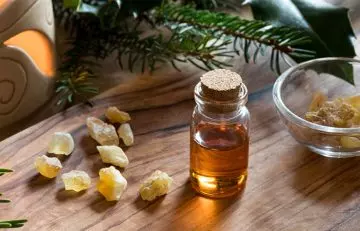
You can use frankincense essential oil to reduce acne and balance hormones through aromatherapy (25). It can also soothe inflammation, reduce oiliness on the skin, and fight bacterial and fungal infections, among other benefits (26).
What You Can Do: Mix 2-3 drops of frankincense oil with a carrier oil like jojoba oil or coconut oil. Dab it on the affected area and let it get absorbed into the skin. You can also pour a few drops of this oil into a diffuser and place it in the room you are sitting in.
18. A Sulfur Mask
Sulfur unclogs blocked pores and can inhibit the growth of Propionibacterium acnes. It has shown to be an effective clinical topical agent in managing acne (21).
What You Can Do: Sulfur may cause irritation, so use it in 1-10% concentration. You can find this amount in certain soaps, face washes, creams, and ointments.
19. Vicks Vaporub
Many people claim that Vicks Vaporub reduces acne symptoms, although there is no scientific evidence backing this claim. Some believe that this product can soothe acne because it contains eucalyptus oil, which is known to aid in acne management. Others claim that the cooling effect of the product sucks up the excess oil, and help in cleansing, leaving your skin clean, dry, and fresh.
Note: Do not apply Vicks Vaporub near your eyes as it can cause an intense burning sensation. If you feel a burning sensation or inflammation after applying it to your skin, wash it off with cool water immediately.
What You Can Do: Dab a little Vicks Vaporub onto a cotton swab and gently apply it over the affected area. You can leave it on for an hour or overnight. Be careful not to rub your face too much if you leave it on your skin overnight to avoid getting it into your eyes. Wash it off in the morning.
 Quick Tip
Quick Tip20. Stress Relief
Stress can also cause acne symptoms like pimples. A study showed that participants with higher stress levels had more severe acne (27). Another study conducted in 17 Korean hospitals showed that psychological stress was a triggering factor for acne in 82% of the patients (27),(28).
What You Can Do: Try out stress-relieving therapies like exercise, yoga, meditation, or laughing therapy. You can also talk to a psychologist. Breathing exercises are another good stress management method.
21. Apple Cider Vinegar
Apple cider vinegar (ACV) has gained popularity as a natural remedy for pimples due to its antibacterial and acidic properties. The acetic acid in ACV may help kill bacteria, including the acne-causing P. acnes. Additionally, its natural acids exfoliate the skin, unclogging pores (29). Start with a highly diluted solution and gradually adjust the ratio according to your skin’s tolerance. If you notice any irritation or redness, stop using it and consult a dermatologist. Perform a patch test to avoid adverse reactions. Those with dry skin should not use ACV as it may dry out the skin even more.
What You Can Do: Mix one part of ACV with three parts of water to create a diluted solution. Use a clean cotton ball to apply this mixture directly onto the affected areas after cleansing your face. Leave it on for a few minutes, then wash your face.
Besides these natural remedies, you can also go for some medical treatments to get rid of pimples. Learn more about them in the next section.
Medical Treatment For Pimples
- Over-The-Counter Treatments: Using an over-the-counter 0.1% adapalene gel on the pimples can help in treating them (30). Other topical retinoidsi XA class of natural compounds derived from vitamin A that reduces skin breakouts and prevents post-acne scars. can be used too, like tretinoin (21).
- Spot Treatments: Medicated ointments or cleansers that contain salicylic acid and benzoyl peroxide can be applied on the pimple or the clogged pore on your skin (31). These are known as spot treatments and can help dry out the pimple.
- Antibiotic Treatments: Topical antibiotics like clindamycin and erythromycin can help manage acne (21).
- Combination Therapies: In most cases, dermatologists may recommend a combination of therapies to treat acne (21). They may pair retinol with benzoyl peroxide and suggest some antibiotics as well.
- Non-Comedogenic Sunscreen: Make sure that you use non-comedogenic sunscreen lotions as these can help prevent the clogging of pores on your skin. This, in turn, can reduce the occurrence of pimples from these pores.
Ruri Ohama, a vlogger, shared her eight-year struggle with acne and her journey to clear skin. She explained that her acne was hormonal and stress-induced. She was prescribed Accutane, a medication for severe acne, which finally cured her acne. She said, “I’m feeling good, and the only thing that I regret is not starting Accutane earlier (i).” She warned viewers against taking this strong drug without a medical prescription.
Now, let’s talk about when you need to see a doctor to get treatment for your pimples.
When To See A Doctor
If you have a mild or moderate case of pimples, it will take about 4-6 weeks to subside completely. But if it persists, you will need to consult your dermatologist. They will be able to determine why over-the-counter options have not worked in your favor. This could have happened due to medication side effects, underlying issues, such as hormonal changes, or due to nodules or cystic acne, which is difficult to manage with home remedies.
Diet That Can Control Breakouts
Certain processed foods, such as dairy products, pasta, sweetened cereal, bread, and instant foods, have a high glycemic index. These foods may cause insulin resistance and may lead to changes in sebum production, resulting in acne (32).
You must take care to decrease the intake of high GI foods and include foods rich in dietary fiber and fatty acids (from salmon and mackerel). Studies suggest that the intake of foods with a low glycemic index and low fat can reduce the occurrence of acne (these are associated with an increased incidence of (33). Consuming antioxidants in the form of fruits like strawberries, blueberries, and other vegetables rich in vitamin A and zinc also have a therapeutic effect on acne.
How Can I Prevent Pimples?
1. Wash your face diligently: Your face can gather dirt and grime over the day, and this can lead to the clogging of the pores and, eventually, pimples. Washing your face well can ensure that the pores are not clogged.
2. Don’t pop your pimples: You must never touch or pop your pimples as this can cause the infection to spread and lead to further breakouts.
3. Stay hydrated: Water is your best friend! Staying hydrated ensures that your skin is replenished and your pores don’t remain clogged by the excessive production of sebum.
4. Limit the use of makeup: If you have skin that is prone to pimples, you should not use makeup too frequently. This can aggravate the issue as it can lead to further clogging of your pores and trigger pimples.
5. Lifestyle Changes: Avoid foods like processed foods, dairy products, etc. as these are associated with an increased incidence of acne (34). Make sure that you work out regularly as this can help replenish your skin. Also, make sure that you can get adequate rest.
Pimples are a common occurrence. These natural methods may not work for everyone but are worth trying out. If they have no effect on your pimples, you might have other underlying issues that are causing these outbreaks. Consult your dermatologist in such cases.
Infographic: Dos And Don’ts While Treating Pimples
Pimples are annoying. No one likes getting one, especially around important days or events where you want to look flawless. While you can get rid of them with some easy remedies, certain precautions may help accelerate the process of eliminating them.
Check out the infographic below to learn the dos and don’ts while treating pimples. Illustration: StyleCraze Design Team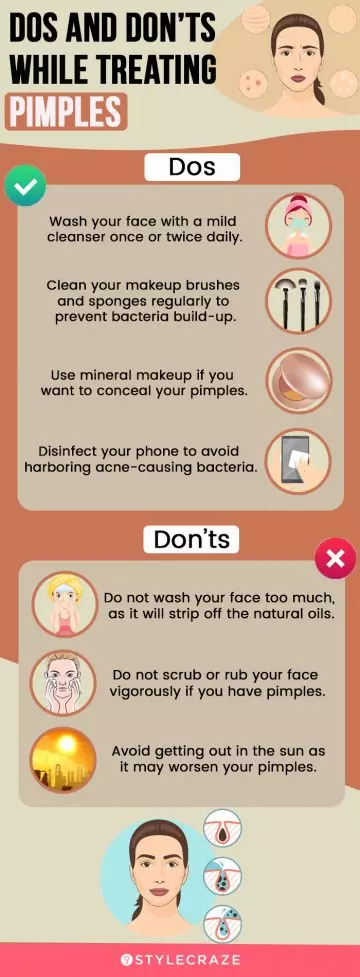
Pimples are typically formed due to clogged pores with excess sebum, dirt, dead skin cells, and sweat. While these inflamed spots on the skin make you eager to find out how to get rid of pimples overnight, the fact is that you cannot remove them so quickly. It takes time for the pores to be cleaned out and the inflammation to subside. However, there are several home remedies that may help reduce the size of the pimple and dry it out overnight. Natural oils with anti-inflammatory properties, Epsom salt, honey, lemon, turmeric, and aloe vera are some of the common ingredients you can use to heal your acne quickly. Some over-the-counter gels and ointments may also help get rid of acne fast.
Frequently Asked Questions
Can coffee cause pimples?
According to Hernandez, “High amounts of coffee consumption can lead to breakouts in some people. Caffeine increases cortisol levels in the body, which leads to increased inflammation and oil production. Coffee drinkers are typically also adding other acne exacerbators such as dairy, soy, and large amounts of sugar.”
What is a blind pimple?
Hernandez says, “A blind pimple is a form of inflamed acne that has not “reached a head”. This is a lesion that can cause a great deal of discomfort, while not being very visible to the eye. The best course of action with this type of pimple is to continue your acne-fighting regimen and introduce icing.”
Is it better to pop a pimple or leave it?
It is strictly not advised to pop your pimples as it can spread the infection and aggravate the problem.
What is the white fluid in a pimple?
The white fluid is pus that is formed by sebum, bacterial infection, and dead skin cells.
What is the difference between acne and pimples?
Pimples are a symptom of acne. Acne occurs when the pores of your skin get clogged with excessive sebum or dead skin cells. It can lead to the occurrence of whiteheads, blackheads, blemishes, or pimples.
Why are some pimples hard?
Sometimes, sebum, dead skin cells, and bacteria can enter the skin surface. This causes the pimple to harden and can be slightly more challenging to treat.
Which is the best cream for pimples?
If you have a mild case of pimples, you can use over-the-counter facial washes and cleansers to help alleviate the problem. You may also try and use the products listed here. If it is severe, you must consult your dermatologist.
Is toothpaste good for pimples?
Toothpaste is formulated with chemicals that can help dry the pimple out and eventually eliminate it. However, excessive usage of toothpaste can cause a burning sensation and scarring.
Does lack of sleep cause pimples?
Yes, lack of sleep can cause acne or worsen existing acne. Research suggests that poor sleep and fatigue upon waking have a positive correlation with the development of acne (35). Further research is needed to understand the underlying mechanisms.
Can depression cause pimples?
Studies have found a relationship between symptoms of depression and acne. According to research, depression may worsen existing acne, and acne may lead to depression (35), (36).
Key Takeaways
- Ice and aloe vera may reduce inflammation as they have anti-inflammatory properties.
- Honey and garlic may reduce pimple size and redness because of their antibacterial properties.
- Lemon juice dries the pimple out and may provide relief by reducing the size.
- Keep your face clean and stay hydrated.
- Consume foods rich in dietary fiber and fatty acids.
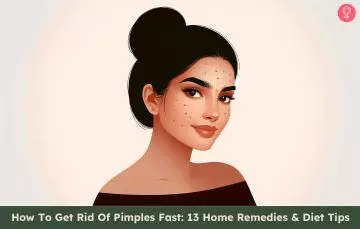
Image: Dall·E/StyleCraze Design Team
Tired of acne? Click on this video to know more about simple home remedies that can help you get rid of those pesky pimples easily.
Personal Experience: Source
StyleCraze's articles are interwoven with authentic personal narratives that provide depth and resonance to our content. Below are the sources of the personal accounts referenced in this article.
i. How I got rid of my acne after 8 years – only thing worked,https://www.youtube.com/watch?v=1LxK-ZQ4fd0
References
Articles on StyleCraze are backed by verified information from peer-reviewed and academic research papers, reputed organizations, research institutions, and medical associations to ensure accuracy and relevance. Read our editorial policy to learn more.
- Acne: Overview US National Library of Medicine National Institutes of Health.
https://www.ncbi.nlm.nih.gov/books/NBK279211/ - Melaleuca alternifolia (Tea Tree) Oil: a Review of Antimicrobial and Other Medicinal Properties Clinical Microbiology Reviews US National Library of Medicine National Institutes of Health.
https://www.ncbi.nlm.nih.gov/pmc/articles/PMC1360273/ - The Anti-proliferative and Anti-bacterial Activity of Argan oil and Crude Saponin Extract from Argania spinosa (L.) Skeels Pharmacognosy Journal.
https://phcogj.com/sites/default/files/PharmacognJ-11-1-26.pdf - Clinical and instrumental study of the efficacy of a new sebum control cream. Journal of Cosmetic Dermatology US National Library of Medicine National Institutes of Health.
https://www.ncbi.nlm.nih.gov/pubmed/17524128 - Clay jojoba oil facial mask for lesioned skin and mild acne–results of a prospective observational pilot study. Complementary Medicine Research US National Library of Medicine National Institutes of Health.
https://www.ncbi.nlm.nih.gov/pubmed/22585103 - Jojoba in dermatology: a succinct review. Giornale Italiano Di Dermatologia E Venereologia US National Library of Medicine National Institutes of Health.
https://www.ncbi.nlm.nih.gov/pubmed/24442052 - Therapeutic role of Ricinus communis L. and its bioactive compounds in disease prevention and treatment Asian Pacific Journal of Tropical Medicine.
https://www.researchgate.net/publication/324079236_Therapeutic_role_of_Ricinus_communis_L_and_its_bioactive_compounds_in_disease_prevention_and_treatment - The use of Epsom salts historically considered CMAJ US National Library of Medicine National Institutes of Health.
https://www.ncbi.nlm.nih.gov/pmc/articles/PMC1584988/ - Cosmetic and Therapeutic Applications of Fish Oil’s Fatty Acids on the Skin. Marine Drugs US National Library of Medicine National Institutes of Health.
https://www.ncbi.nlm.nih.gov/pubmed/30061538 - Effects Of Fish Oil Supplementation On Inflammatory Acne Lipids In Health And Disease BMC US National Library of Medicine National Institutes of Health.
https://www.ncbi.nlm.nih.gov/pmc/articles/PMC3543297/ - Anti-inflammatory analgesic and antipyretic activities of virgin coconut oil. Pharmaceutical Biology US National Library of Medicine National Institutes of Health.
https://www.ncbi.nlm.nih.gov/pubmed/20645831 - The Properties of Lauric Acid and Their Significance in Coconut Oil Journal of the American Oil Chemists’ Society.
https://link.springer.com/article/10.1007/s11746-014-2562-7 - Garlic: a review of potential therapeutic effects Avicenna Journal of Phytomedicine US National Library of Medicine National Institutes of Health.
https://www.ncbi.nlm.nih.gov/pmc/articles/PMC4103721/ - Evidence based medical use of aloe vera extracts short review of literature International Journal of Research in Medicine ResearchGate.
https://www.researchgate.net/publication/320098633_Evidence_based_medical_use_of_aloe_vera_extracts_short_review_of_literature - A Honey Trap for the Treatment of Acne: Manipulating the Follicular Microenvironment to Control Propionibacterium acnes National Journal of Maxillofacial Surgery US National Library of Medicine National Institutes of Health.
https://www.ncbi.nlm.nih.gov/pmc/articles/PMC3666392/ - Biological Activities and Safety of Citrus spp. Essential Oils MDPI US National Library of Medicine National Institutes of Health.
https://www.ncbi.nlm.nih.gov/pmc/articles/PMC6073409/ - Effects Of Turmeric (Curcuma longa) On Skin Health: A Systematic Review Of The Clinical Evidence Phytotherapy Research US National Library of Medicine National Institutes of Health.
https://pubmed.ncbi.nlm.nih.gov/27213821/ - Curcumin: A Review of Its’ Effects on Human Health MDPI US National Library of Medicine National Institutes of Health.
https://www.ncbi.nlm.nih.gov/pmc/articles/PMC5664031/ - Green Tea and Other Tea Polyphenols: Effects on Sebum Production and Acne Vulgaris MDPI US National Library of Medicine National Institutes of Health.
https://www.ncbi.nlm.nih.gov/pmc/articles/PMC5384166/ - Saccharomyces Cerevisiae Yeast-Based Supplementation As A Galactagogue In Breastfeeding Women? A Review Of Evidence From Animal And Human Studies Nutrients MDPI US National Library of Medicine National Institutes of Health.
https://www.ncbi.nlm.nih.gov/pmc/articles/PMC7996189/ - A Review Of Diagnosis And Treatment Of Acne In Adult Female Patients International Journal Of Women’s Dermatology US National Library of Medicine National Institutes of Health.
https://www.ncbi.nlm.nih.gov/pmc/articles/PMC5986265/#d31e926 - Treatment Of Acne With A Yeast Preparation Fortschritte Der Medizin US National Library of Medicine National Institutes of Health.
https://pubmed.ncbi.nlm.nih.gov/2530145/ - Treatment Modalities For Acne Molecules MDPI
https://www.researchgate.net/publication/306132621_Treatment_Modalities_for_Acne - The Age-Old Problem Of Acne International Journal Of Women’s Dermatology
https://www.sciencedirect.com/science/article/pii/S2352647516300284 - Frankincense: Essential Oils And Its Applications First International Conference On Frankincense And Medicinal Plants Natural And Medicinal Science Research Centre
https://www.researchgate.net/publication/329269832_Frankincense_Essential_Oils_and_its_Applications - Commercial Essential Oils As Potential Antimicrobials To Treat Skin Diseases Evidence Based Complementary And Alternative Medicine US National Library of Medicine National Institutes of Health.
https://www.ncbi.nlm.nih.gov/pmc/articles/PMC5435909/ - The Association Between Stress And Acne Among Female Medical Students In Jeddah Saudi Arabia Clinical Cosmetic and Investigational Dermatology US National Library of Medicine National Institutes of Health.
https://www.ncbi.nlm.nih.gov/pmc/articles/PMC5722010/ - A Multicenter Epidemiological Study Of Acne Vulgaris In Korea International Journal Of Dermatology US National Library of Medicine National Institutes of Health.
https://pubmed.ncbi.nlm.nih.gov/21595660/ - Acetic acid and the skin: a review of vinegar in dermatology
https://pubmed.ncbi.nlm.nih.gov/34350993/ - A review of the use of adapalene for the treatment of acne vulgaris Therapeutics and Clinical Risk Management US National Library of Medicine National Institutes of Health.
https://www.ncbi.nlm.nih.gov/pmc/articles/PMC2374937/ - Meta-analysis comparing the efficacy of benzoyl peroxide clindamycin benzoyl peroxide with salicylic acid and combination benzoyl peroxide/clindamycin in acne Database of Abstracts of Reviews of Effects US National Library of Medicine National Institutes of Health.
https://www.ncbi.nlm.nih.gov/books/NBK78892/ - The relationship of diet and acne Dermatoendocrinology US National Library of Medicine National Institutes of Health.
https://www.ncbi.nlm.nih.gov/pmc/articles/PMC2836431/ - Significance of diet in treated and untreated acne vulgaris Advances in Dermatology and Allergology US National Library of Medicine National Institutes of Health.
https://www.ncbi.nlm.nih.gov/pmc/articles/PMC4884775/ - Dairy Intake and Acne Vulgaris: A Systematic Review and Meta-Analysis of 78529 Children Adolescents and Young Adults MDPI US National Library of Medicine National Institutes of Health.
https://www.ncbi.nlm.nih.gov/pmc/articles/PMC6115795/ - Acne Severity and Sleep Quality in Adults, MDPI, US National Library of Medicine National Institutes of Health.
https://www.ncbi.nlm.nih.gov/pmc/articles/PMC7445853/ - Prevalence of mental health problems in acne patients, US National Library of Medicine, National Institutes of Health.
https://pubmed.ncbi.nlm.nih.gov/11873431/





